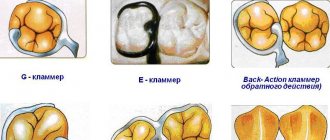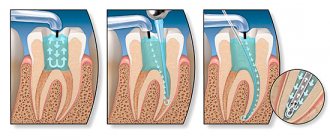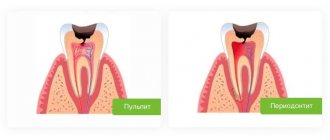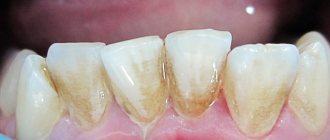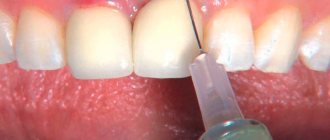Orthodontics is a branch of dentistry aimed at correcting defects in the development of teeth and the maxillofacial skeleton. The result of orthodontic treatment largely depends on the correct diagnosis. Modern diagnostics in orthodontics
performed using special devices and equipment.
In this article we will consider popular methods of orthodontic diagnostics and answer frequently asked questions about orthodontics
.
Diagnostic methods in orthodontics
The treatment of defects of the masticatory-speech apparatus is carried out by a specialized orthodontist. After a visual examination of the patient’s oral cavity, the specialist decides on the need to conduct additional research procedures using modern diagnostic methods. Based on the analysis obtained, it is possible to establish an accurate diagnosis and select the correct treatment to achieve a successful result.
Diagnostic methods in orthodontics:
1. Radiography.
2. Tomography of the temporomandibular joint.
3. Orthopantomography.
4. Examination using diagnostic models (taking impressions of the patient’s jaw with subsequent production of working models).
5. Electromyography.
6. Mask model (determining facial asymmetry taking into account three planes).
7. Simon's photostat.
8. Teleradiography.
The most popular diagnostic methods in orthodontics are dental radiography and orthopantogram, which allow identifying various deviations of the dentofacial apparatus. In difficult cases, additional research methods are used to clarify the identified pathologies.
Diagnostics is carried out in several stages:
- Taking impressions of teeth
. For this, alginate or silicone material is used. Based on the casts, plaster jaw models are made. - Orthopantomogram
. For this, a special X-ray machine is used to take a picture of the jaws. Thus, the doctor determines the condition and location of the tooth roots and tissues around them. Achieving success in orthopedics directly depends on the general condition of the periodontium - teeth and tissues must be healthy. - Teleradiogram
. A lateral x-ray of the skull is taken. Using this image, the doctor determines the angle of inclination of the front teeth on both jaws and the direction of growth of the jaw structures. A teleradiogram helps the doctor conduct an orthodontic analysis, study the bone tissue in detail, and identify the level of location of the soft tissues of the oral cavity. - Computer tomogram.
- Photo protocol (diagnostic photographs).
- Facial aesthetics
is part of orthodontic treatment. When drawing up a treatment plan, the doctor takes into account the shape of the patient’s lips, chin, nose, facial contours and features of the patient’s smile.
An orthopantomogram provides the doctor with a high-quality image in which he sees bone tissue, main sinuses, roots and pathologies with visible boundaries.
The listed diagnostic methods enable the orthodontist to carry out detailed calculations for medical procedures and prepare a competent treatment plan.
Orthodontic treatment may be necessary and desirable. In case of violations at the aesthetic level with the absence of pathology of the dental system, the doctor prescribes the desired treatment. In this case, the patient can resort to treatment, refuse it, or postpone it for a while. Indications for the necessary treatment are obvious deviations leading to disruptions in the proper functioning of the dental system.
It is a mistake to think that only children and adolescents need such treatment. Every year, more and more age-related changes occur in the oral cavity of adults. Some of them can be observed by a person himself (for example, abrasion, yellowing of teeth, cracks), some can only be diagnosed by an orthodontist (deepening of the bite, crowding, lengthening of teeth, and so on).
A thorough diagnosis is necessary when a doctor decides whether to remove teeth during treatment. By removing some teeth, the doctor can solve the problem of lack of space and easily align the teeth along the arch. However, this is only an extreme case when treatment without removal is inappropriate. An experienced master does not resort to such methods and does everything possible to save all the patient’s healthy teeth.
Questions about orthodontics
Many patients have different questions about orthodontics. Let's look at the most popular ones.
Is it possible to correct dental defects without braces?
The vestibular brace system is by far the most effective way to correct bite defects. But as an alternative, the patient may be offered aligners. A set of mouth guards is made from impressions taken from the patient’s jaw. While wearing them, you must maintain careful oral hygiene. The orthodontic structure is changed once a month. The patient needs to regularly visit an orthodontist to monitor the treatment process.
Cons of aligners:
- Not suitable for everyone;
- not used in complex cases;
- are more expensive than braces.
How quickly do teeth straighten with braces?
On average, teeth move into an even arch after 3-4 months. These periods can be shortened or increased, depending on the type of braces chosen and the complexity of the particular case.
What is the function of orthodontic screws?
Screws in orthodontics
are used to stabilize the brace system in the absence of some teeth in a row, as well as in case of bone tissue atrophy. They eliminate the movement of supporting teeth and speed up the process of dental correction.
How do teeth move?
In some cases, it becomes necessary to move one or more teeth. For this purpose, orthodontists use removable or non-removable structures. Fixed bracket systems include bracket systems that ensure the movement of teeth in the desired direction, under the supervision of a specialist.
Types of tooth movement in orthodontics
:
1. Corpus technique, which involves moving the tooth crown and root in one direction.
2. Oblique-rotational – involves moving the crown and tooth root to different distances.
In orthodontic treatment, it is possible to move not only one tooth, but also a whole series. This technique is successfully used in the treatment of occlusion with a distal position of the lower jaw.
When are orthodontic implants installed?
When treating complex defects of the dental system, there is often a need to install orthodontic implants aimed at providing the necessary support for fixed structures that correct bite defects.
Indications for installation of orthodontic implants:
- crowded dentition;
- strong protrusion of molars or front incisors;
- distal bite;
- severe curvature of teeth;
- if it is necessary to change the size or position of the jaw;
- to ensure the required degree of impact on the dentition (if braces do not cope with this task);
- lack of positive results after wearing braces for a long time.
Implants in orthodontics
differ from standard designs used to restore lost teeth. They are smaller in size and thickness, are installed temporarily, and the implantation method itself is minimally invasive and does not require cutting the gums or suturing.
How will be correct?
Now we will tell you what steps our diagnostic presentation consists of.
Analysis of diagnostic models.
An electronic caliper is used to calculate the space deficit for each tooth on a plaster model of the jaws. The data is transferred to the presentation.
Analysis of X-ray images.
The data is calculated in special computer programs. Based on them, the main conclusions are drawn.
Assessment of periodontal status (level of gums and frenulum).
Assessment of facial parameters.
The main questions at this stage are: is it possible to delete? Won't this spoil the profile? Even if removal is required due to the bite, the face is always a priority.
Assessment of smile and incisor visibility at rest.
It is important to understand which teeth are more visible when speaking - the upper or lower ones. It has been proven that greater visibility of the upper teeth significantly makes the face look younger and more attractive. It works better than any anti-aging cream One of the basic goals of any treatment.
It has been proven that greater visibility of the upper teeth significantly makes the face look younger and more attractive. It works better than any anti-aging cream One of the basic goals of any treatment.
Width of a smile.
The more teeth you see in a smile, the wider and more open it appears.
Expressiveness of the smile line.
The most charming smile is considered to be the one that closely follows the contour of the lower lip. Also the basic goal of any treatment. More details about the canons of the beauty of a smile are written in our article - What is a beautiful smile.
Planning the positioning of braces on the teeth according to the findings of the smile analysis.
As you can see, half an hour spent in the chair by the patient results in a lot of “behind the scenes” work for the thoughtful orthodontist.
Treatment planning is creative, painstaking work. Unfortunately, not all orthodontists these days fully understand this process. They are not ready to lay this foundation, without which it is impossible to build good and stable treatment in the long term.
Orthodontics is not about fixing braces. Teeth can be as straight as desired, but the smile, nevertheless, remains very mediocre, the profile of the face - spoiled by removal “in the name of teeth.”
Our treatment directly affects the appearance, because the result remains with the patients forever! Therefore, the fundamental point in treatment is only the right choice of doctor!
The main thing is to get into reliable, experienced hands. And if you are reading this, then you are already on the right track!
Orthodontic treatment of bite defects in
Experienced orthodontists who see patients at the specialized dental clinic “Aesthetics” are ready to answer all your questions about orthodontics. The center is equipped with modern diagnostic equipment that gives highly accurate results, which guarantees a quick correct diagnosis and the correct choice of treatment protocol.
Orthodontic treatment uses high-quality lingual braces, mouth guards, plates and other structures that can effectively eliminate various malocclusion defects, even in the most difficult cases. You can make an appointment with an orthodontist by phone. The first consultation appointment is free.
All patients who leave reviews on our website are guaranteed to receive an additional 3% discount on everything dental (the discount is added to the client’s main discount). Share your opinion and experience of orthodontic treatment in our clinic, do not miss the opportunity to save your own money on the services of an experienced orthodontist!
What is diagnostics through the eyes of the doctors at our clinic?
More than one (!) hour of work in the clinic to create a presentation after the diagnosis, which will contain conclusions on a large number of evaluation criteria. Why is this happening?
You need to understand that all doctors have completely different approaches to analyzing diagnostic data.
Some people don’t do it at all and are ready to lay out a treatment plan immediately during the consultation without the slightest doubt. And this, in general, does not indicate high qualifications, rather the opposite.
For some doctors, one panoramic (overview) image and casts are enough. Which is also unacceptable for a modern orthodontist.
What does functional orthodontics include?
- joint treatment by an osteopath and a dentist;
- equalizing the pressure between the muscles of the tongue and the muscles of the cheeks and lips through special exercises - uneven muscle tension during the period of jaw growth can cause significant deformations of the jaws;
- wearing jaw growth activators;
- installation of removable pads;
- installation of non-removable expansion pads;
- jaw expansion using the Planas apparatus;
- expansion with ALF and Crozat devices;
- finishing linings to stabilize the bite and occlusal planes in the presence of tooth wear.
Symptoms
The specificity of the manifestations depends on the specific type of defect. At the first symptoms indicating the presence of abnormalities, it is recommended to undergo a comprehensive orthodontic diagnosis, the results of which determine the need for dental treatment. Characteristics that deserve attention include:
- Violation of the occlusion of the elements of the upper and lower row.
- Formation of spaces between teeth.
- Curved position of individual units.
- Intense accumulation of plaque and tartar.
- Complete coverage of the crown surface.
- Bleeding gums during hygienic cleaning.
- Deviation of facial symmetry.
- Speech defects, problems with breathing and posture.
- Extraneous sounds and difficulty opening the mouth.
Various types and varieties of malocclusion are characterized by the presence of common features - in all cases the patient experiences physical and psychological discomfort associated with impaired functionality and aesthetics. Muscle strain provokes increased fatigue and can also cause regular pain, manifested in the occipital and cervical region.
